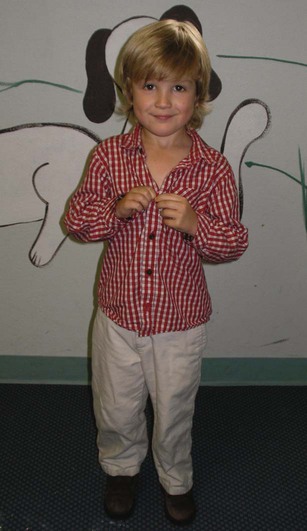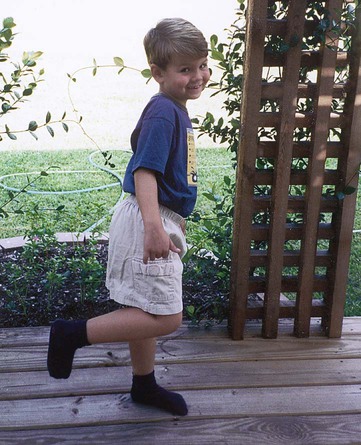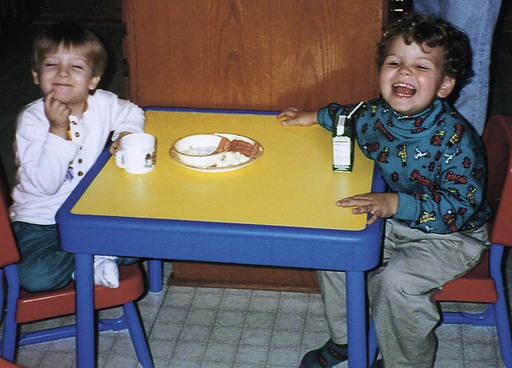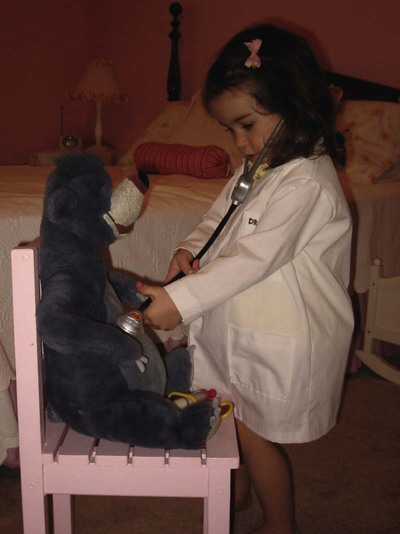On completion of this chapter the reader will be able to: • Identify the major biologic, psychosocial, cognitive, moral, spiritual, and social developments that occur during the preschool years. • List the benefits of imaginary playmates. • Prepare preschoolers for preschool or daycare experience. • Provide parents with guidelines for sex education. • Provide parents with guidelines for dealing with a child’s fears, stresses, aggression, and sleep problems. • Recognize the causes of stuttering during the preschool years. • Offer parents suggestions for preventing speech problems. • Recognize the feeding patterns of preschoolers. • Provide anticipatory guidance to parents regarding injury prevention based on the preschooler’s developmental achievements. http://evolve.elsevier.com/wong/essentials Walking, running, climbing, and jumping are well established by age 36 months. Refinement in eye–hand and muscle coordination is evident in several areas. At age 3 years, preschoolers can ride a tricycle, walk on tiptoe, balance on one foot for a few seconds, and do broad jumps. By age 4 years, children can skip and hop proficiently on one foot (Fig. 13-1) and catch a ball reliably. By age 5 years, children can skip on alternate feet and jump rope and begin to skate and swim. Development of the superego, or conscience, begins toward the end of the toddler years and is a major task for preschoolers (see Cultural Considerations box). Learning right from wrong and good from bad is the beginning of morality (see Moral Development). Piaget’s cognitive theory does not include a period specifically for children who are 3 to 5 years old. The preoperational phase covers the age span from 2 to 7 years and is divided into two stages: the preconceptual phase, ages 2 to 4 years, and the phase of intuitive thought, ages 4 to 7 years. One of the main transitions during these two phases is the shift from totally egocentric thought to social awareness and the ability to consider other viewpoints. However, egocentricity is still evident. (For a review of the characteristics of preoperational thought, see Chapter 12.) Development of the conscience is strongly linked to spiritual development. At this age, children are learning right from wrong and behaving correctly to avoid punishment. Wrongdoing provokes feelings of guilt, and preschoolers often misinterpret illness as a punishment for real or imagined transgressions. Observing religious traditions and participating in a religious community can help children cope during stressful periods, such as illness and hospitalization (Speraw, 2006). The preschool years play a significant role in the development of body image. With increasing comprehension of language, preschoolers recognize that individuals have desirable and undesirable appearances. They recognize differences in skin color and racial identity and are vulnerable to learning prejudices and biases. They are aware of the meaning of words such as pretty or ugly, and they reflect the opinions of others regarding their own appearance. By 5 years of age, children compare their size with that of their peers and can become conscious of being large or short, especially if others refer to them as “so big” or “so little” for their age. Research indicates that girls as young as preschool age already show concern about appearance and weight (Skouteris, McCabe, Swinburn, and others, 2010). Because these are formative years for both boys and girls, parents should make efforts to instill positive principles regarding body image, give their children encouraging feedback regarding their appearance, and emphasize the importance of accepting individuals no matter their differences in appearance. Sexual exploration may be more pronounced now than ever before, particularly in terms of exploring and manipulating the genitalia. Questions about sexual reproduction may come to the forefront in preschoolers’ search for understanding (see Sex Education, p. 415, and in Chapter 15). During the preschool years, language becomes more sophisticated and complex and becomes a major mode of communication and social interaction (Fig. 13-2). Through language, preschool children learn to express feelings of frustration or anger without acting them out. Both cognitive ability and environment—particularly, consistent role models—influence vocabulary, speech, and comprehension. Vocabulary increases dramatically, from 300 words at age 2 years to more than 2100 words at the end of 5 years. Sentence structure, grammatical usage, and intelligibility also advance to a more adult level. Language development during these early years predicts school readiness (Harrison and McLeod, 2010) and sets the stage for later success in school (Reilly, Wake, Ukoumunne, and others, 2010). The pervasive ritualism and negativism of toddlerhood gradually diminish during the preschool years. Although self-assertion is still a major theme, preschoolers demonstrate their sense of autonomy differently. They are able to verbalize their request for independence and perform independently because of their much-refined physical and cognitive development. By 4 or 5 years of age, they need little if any assistance with dressing, eating, or toileting (Fig. 13-3). They can also be trusted to obey warnings of danger; however, 3- or 4-year-old children may exceed their boundaries at times. They are also much more sociable and willing to please. They have internalized many of the standards and values of the family and culture. However, by the end of early childhood, they begin to question parental values and compare them with those of their peer group and other authority figures. As a result, they may be less willing to abide by the family’s code of conduct. Preschoolers become increasingly aware of their position and role within the family. Although this is a more secure age for experiencing the addition of another sibling, relinquishing the position of first or youngest is still difficult and requires appropriate preparation. (See Sibling Rivalry, Chapter 12.) Play activities for physical growth and refinement of motor skills include jumping, running, and climbing. Tricycles, wagons, gym and sports equipment, sandboxes, wading pools, and activities at water parks can help develop muscles and coordination (Fig. 13-4). Activities such as swimming and skating teach safety as well as muscle development and coordination. Children involved in the work of play do not require expensive toys and gadgets to keep them entertained but often enjoy playing with common household items such as a broom handle or even items adults consider junk (boxes, sticks, rocks, and dirt). The imaginative mind of the preschooler enjoys playing for play’s sake. Probably the most characteristic and pervasive preschool activity is imitative, imaginative, and dramatic play. Dress-up clothes, dolls, housekeeping toys, dollhouses, play store toys, telephones, farm animals and equipment, village sets, trains, trucks, cars, planes, hand puppets, and medical kits provide hours of self-expression (Fig. 13-5). Probably at no other time is the reproduction of adult behavior so faithful and absorbing as in 4- and 5-year-old children. Toward the end of the preschool period, children are less satisfied with make-believe or pretend objects and enjoy doing the actual activity, such as cooking and carpentry. Television and other media also have their place in children’s play, although each should be only one part of children’s total repertoire of social and recreational activities. Parents and other caregivers should supervise the selection of programs, watch and discuss programs with their children, schedule limited time for television viewing, and set a good example of television viewing (American Academy of Pediatrics [AAP], 2007). Children enjoy and learn from educational programs; however, television viewing may limit time spent in other meaningful activities such as reading, physical activity, and socialization (AAP, 2007). Although the potential negative effects of television viewing have been well documented in literature, research has also shown that prosocial behavior and later academic achievement can result from viewing educational media during the preschool years; however, positive effects depend on the media content, the age of the viewer, the length of viewing time, and the presence of a coviewing parent (Kirkorian, Wartella, and Anderson, 2008). When parents view media with their children, the activity can become interactive with parents and children discussing program content. Considering the significant increase in media accessibility through various portable electronic devices and cell phones, parents need to be aware of the potential positive and negative effects of media exposure. Play is so much a part of young children’s lives that reality and fantasy become blurred. Make-believe is reality during play and only becomes fantasy when the toys are put away or the dress-up clothes are removed. It is no wonder that imaginary playmates are so much a part of this age period. The appearance of imaginary companions usually occurs between ages Table 13-1 summarizes the major developmental achievements for children 3, 4, and 5 years of age. TABLE 13-1 GROWTH AND DEVELOPMENT DURING THE PRESCHOOL YEARS Usual weight gain of 1.8–2.7 kg (4–6 pounds) Average weight of 14.5 kg (32 pounds) Usual gain in height of 7.5 cm (3 inches) per year Average height of 95 cm (37.5 inches)
Health Promotion of the Preschooler and Family
Promoting Optimal Growth and Development
Biologic Development
Gross and Fine Motor Skills
Psychosocial Development
Developing a Sense of Initiative (Erikson)
Cognitive Development
Preoperational Phase (Piaget)
Spiritual Development
Development of Body Image
Development of Sexuality
Social Development
Language
Personal-Social Behavior

Play
 and 3 years, and for the most part, such playmates are relinquished when the child enters school. Differences in birth order and gender have been noted in studies of imaginary companion play. Firstborn children have a higher incidence of imaginary companions, as do young girls; young boys tend to impersonate characters more often (Trionfi and Reese, 2009).
and 3 years, and for the most part, such playmates are relinquished when the child enters school. Differences in birth order and gender have been noted in studies of imaginary companion play. Firstborn children have a higher incidence of imaginary companions, as do young girls; young boys tend to impersonate characters more often (Trionfi and Reese, 2009).
PHYSICAL
GROSS MOTOR
FINE MOTOR
LANGUAGE
SOCIALIZATION
COGNITION
FAMILY RELATIONSHIPS
Age 3 Years
![]()
Stay updated, free articles. Join our Telegram channel

Full access? Get Clinical Tree

 Get Clinical Tree app for offline access
Get Clinical Tree app for offline access

Health Promotion of the Preschooler and Family
Get Clinical Tree app for offline access

 to
to  years of age.
years of age.

